The Cyclades islands are forming a ring of around the ancient island of Delos with its ancient ruins and temples, next to the cosmopolitan island of Mykonos.
The islands of Cyclades include Syros, Naxos, Sifnos, Serifos, Paros, Ios, Santorini with its volcano and amazing sun sets and of course the small islands south of Naxos Schinousa, Donousa, Heraklia and Koufonisia a truly beautiful archipelago.
Cyclades islands is an ideal sailing destination offering over 20 islands all within easy reach with countless bays to anchor in all within very easy reach, so even if you are not the most experienced or adventurous of sailors you can fill every day with something new.
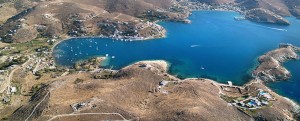 KEA
KEA
Kea is the closest of theCycladesto the mainland, it has a shoreline of 81km. While it appears barren from a distance, the bare hills hide fertile valleys filled with orchards and olive groves.
The main settlements are theportofKorissia, set on a large bay with a sandy beach and the capital, Ioulida, which is a pleasant hillside town, full of alleyways and winding steps. Around Kea
The island’s best beach Pisses is a long sandy cove backed by a green valley of orchards and olive groves. Koundouros, lies on a bay of crystal clear water, while the sandy beach at Poles sits on the ancient site of Karthea on the southeastern side of the island.
Vourkari, a popular stop for yachts, is a trendy resort filled with lovely shops. Otzias is a picturesque village enclosed in a cove.
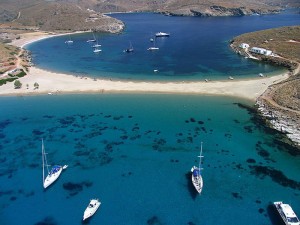 KYTHNOS
KYTHNOS
Kythnos is extremely popular with Athenian holidaymakers. The villages, Hora and Dryopida are typically Cycladic with their winding streets and windmills. There are a number of pretty little bays all along the coastline. On the northeastern side of the island lies Loutra, a popular summer spot renowned for its thermal springs.
The best beaches are on the southeastern coast, near thevillageofKanala. Below the monastery Panagia Knanlia There are also several sandy beaches located north and south of Merihas, such as Episkopi and Apokrousi and Flambouria.
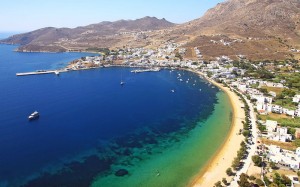 SERIFOS
SERIFOS
From afar, the island of Serifos appears like a great rock rising out of the sea. Clinging on the hillside above the main port, Livadi, is the dazzling whitewashed capital Hora, it is one of the most striking Cycladic capitals.
There are several good beaches to visit, such as the tamarisk-fringed beach at Livadakia, Karavi, which is the unofficial nudist beach and Lia.
Psili Ammos and the sheltered bay of Agios Sostis, are also good choices. Norheast of the island is uninhabited islet of Serfopoula.
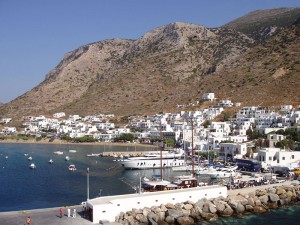 SIFNOS
SIFNOS
The capital, Apollonia, is a lovely whitewashed village set on a plateau 5km up from theportofKamares. 3km from Apollonia is the walled cliff-topvillageofKastro, it is a magical place of buttressed alleys and whitewashed houses.
Around Sifnos The resort of Platys Gialos has a long sandy beach, nearby is the spectacularly situated Moni Hrysopigilis. A path from the monastery leads to a beach with a taverna. Vathi, on the west coast, is a gorgeous sandy bay. Faros is a cozy little fishing hamlet with a couple of nice beaches.
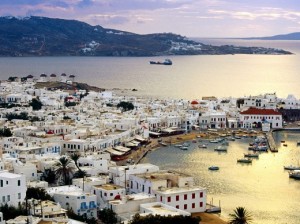 MYKONOS
MYKONOS
Mykonosis perhaps the most visited of all Greek islands. It has by far the most sophisticated and exciting nightlife inGreece.
Whitewashed Hora, the islands main port is a labyrinth of winding cobbled stoned alleys. Despite the throngs of people, it is most beautiful. The waterfront is filled with colorful fishing boats (caiques), and windmills spot the surrounding hilltops.
There are five museums to visit: the archaeological, the folklore, the Aegean Maritime, the windmill, andLena’s house (19th century Mykonian house with furnishings). The Panagia Paraportiani is the most famous ofMykonos’ several hundred churches. It is actually four little churches united into one beautiful white, knobby, asymmetrical structure. It is a photographer’s dream Beaches
To the south beyond Ornos, is Agios Ioannis and to the east is Psarou, a lovely little cove. The islands best beaches are further around the south coast:Paradise, Super Paradise, Agrari and Elia. Nudism is accepted on all these beaches. Elia is the least crowded. North coast beaches are exposed to the meltemi winds, but Panormos and Agios Sostis are sheltered and uncrowded. Dragonisi is an uninhabited islet east of Mykonos.
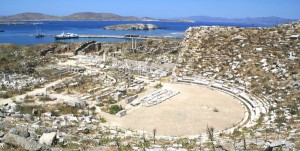 DELOS
DELOS
Lying a few kilometers off the west coast of Mykonos is Delos, one of the most important archaeological sites inGreece. This sacred, barren island is the mythical birthplace of Apollo and Artemis. In the 8th century BC, a festival in honor of Apollo was established; the oldest temples and shrines date from this era. But Delos did not reach the height of its power until the Hellenistic period, becoming one of the three most important religious and commercial centers inGreece. It was populated with wealthy merchants, mariners and bankers from as far away asEgyptandSyria. Although Apollo was the principle deity these inhabitants erected temples to the various gods revered in their native lands. Exploring the Site
1. The Theatre Quarter, whereDelos’ wealthiest inhabitants built their lavish houses.
2. The theatre (300 BC)
3. The Sanctuary of Apollo contains temples dedicated to him.
4. Terrace of the Lions
5. Harbor Quarter
6. The Sanctuaries of the Foreign Gods
7. Sacred Mt Kynthos (113m)
8. The SacredLake
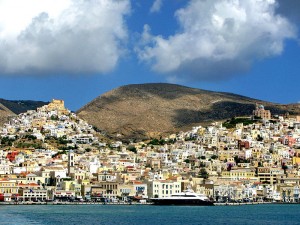 SYROS
SYROS
The capital ofSyrosis Ermoupolis, an affluent, lively town of elegant neoclassical mansions, squares, marble paved streets and chic boutiques. As your boat sails into the harbor you will catch a glimpse of the Catholic settlement of Ano Syros to the left, and the Orthodox settlement of Vrodado to the right, both situated on hills with Ermoupolis spilling down to the harbor, it is an impressive sight. Ano Syros is a medieval settlement with narrow alleyways and whitewashed houses. It is a fascinating place to visit.
Beaches
The west coast resort of Galissas has one of the island’s finest beaches: a 900m crescent of sand, shaded by tamarisk trees. South of Galissas is Finikas with a lovely tree-lined beach and Posidonia which has a shaded sand and pebbled beach and Agathopes. The tranquil Megas Gialoson on the south coast has two sand beaches.
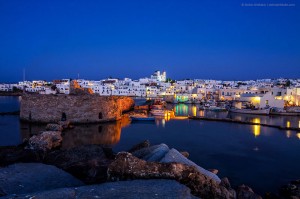 PAROS & ANTIPAROS
PAROS & ANTIPAROS
Parosis an attractive island of terraced hills, whitewashed settlements and windmills. It is the center of theCyclades. The island’s busy capital and port is Parikia, a charming, typically Cycladic old town with a 13th century Venetian kastro.
The Pangia Ekatontapyliani church, which dates from 326 AD is one of the most splendid in theCyclades. Naoussa, on the north coast is a popular resort at the heart of which is a colorful fishing village. Although it has an up market feel to it Naoussa is still a working harbor with piles of fishing nets, bright caiques, and little ouzeria. It is a relaxed, picturesque village with whitewashed alleyways. There are a number a good beaches close-by, the best are Kolimvythres, Monastiri, andSanta Maria. Lefkes, 12km southeast of Parikia, is the island’s highest and loveliest village. In July and August Petaloudes is almost enshrouded in butterflies, the sight is spectacular. Other beaches worth visiting are Piso Livadi, Krios and Hrysi Akti. Opposite from Dryos is the tiny islet Dryonis, which is fantastic for fishing.
ANTIPAROS
This small islands lies off the southwest coast ofParos, it has a coastline of56 km. The main village, Antiparos is an attractive and charming port. TheCaveofAntiparosis an awe-inspiring site. At the entrance is a small chapel dedicated toSt Johnfrom here the steps descend deep into the stalactite and stalagmite filled cave. There are a number of good beaches to visit: Psaslyki, Sifnakos Gialos, Agios Gialos and Strongyle. The small islets, which surround the Antiparos have formed narrow straits between them.
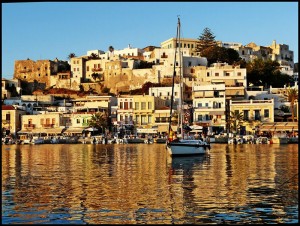 NAXOS
NAXOS
Naxos is the largest of theCyclades. Its rugged mountains and fertile green valleys also make it one of the most beautiful. Mt Zeus (1004m) is the archipelago’s highest peak. It was a prominent Byzantine center with over 500 churches and monasteries.
Hora is the island’s capital and port. The most alluring part of Hora is Kastro, with its winding alleyways and whitewashed houses. There are also some handsome Venetian dwellings. It has a medieval atmosphere. A causeway to the north of the port leads to the islet of Palatia and the unfinishedTempleofApollo. The lovely Tragaea region is a vast plain of olive groves and unspoilt villages harboring numerous little Byzantine churches.
Beaches
Agios Georgios is a resort town with golden sands and shallow waters. The next beach south is Agios Prokopios, a sheltered bay, followed by Agia Anna, a lovely beach of fine sand.Sandybeaches continue as far down as Pyrgaki.
Plaka is one of the island’s most beautiful beaches, it is mainly nudist. Mikri Vigla and Kastraki are also worth mentioning.
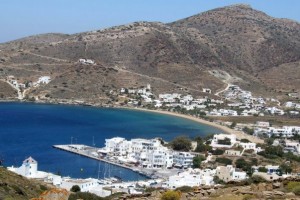 IOS
IOS
There is no denying that most visitors flock to Ios to party hard, but for those seeking relaxation, Ios has plenty to offer amongst its beautiful beaches and charming capital, Hora. Hora is a lovely Cycladic village with narrow whitewashed laneways and houses. At night the tiny central square is transformed into a crowded open-air party. Apart from the nightlife, the beaches are what lure travelers to Ios. Competing with Milopotas for the best beach is Manganari, which has a long swathe of fine white sand. Nearby,KolitzaniBeachand Tsamaria are also nice. Agio Theodoti, Psathi and Kalamos beaches, all on the northeast coast, are more remote.
LITTLE CYCLADES
The Little Cyclades is a chain of small islands betweenNaxosand Amorgos. Only four have permanent populations: Donousa, Koufonisia, Iraklia and Shinousa. They attract a few tourists looking for splendid beaches and a laid back atmosphere.
Donousa the northernmost of the group and the farthest fromNaxos, was the site of numerous archeological finds. The others are clustered three nautical miles south ofNaxos. Sailing from island to island will prove to be a special adventure.
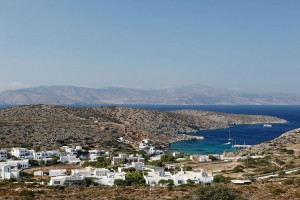 Iraklia
Iraklia
The port and main village is Agios Georgios, which has a pretty, deep cove like harbor. There is a nice beach, Livadi and a cave with fine stalactites.
Shinousa
Shinousa is a wonderful little island with a lively hora and friendly residents. The hora has vast views of the sea and neighboring islands. Around the island there are several fine bays and sandy beaches, such as Tsigouri and Psili Ammos.
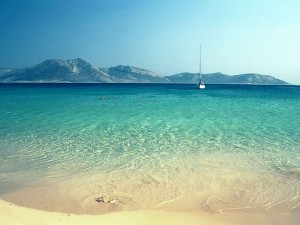 Koufonisia
Koufonisia
Koufonisia is really two islands, Ano Koufonisia and Kato Koufonisia, but only the latter is permanently inhabited. Although it is the smallest of the Little Cyclades, it is the most densely populated. The island has the largest fishing fleet inGreece, every family is involved with the trade. The residents are very hospitable. The beaches are outstanding: low-lying white sand dunes, covered with wild flowers and rocky coves.
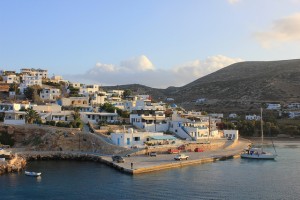 Donousa
Donousa
Danousa is the most remote the group. It has 130 inhabitants. Agios Stavros is the main settlement and port. Kendros is a lovely, sandy and secluded beach.
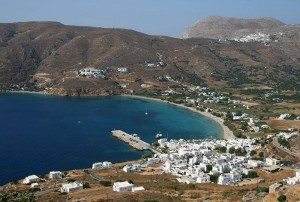 AMORGOS
AMORGOS
Amorgos is the most easterly of the Cyclades, it is most enticing. Katapola the main port is a pretty town on a large dramatic bay. The village of Horais an impressive sight. Rising 400m above sea level, shrouded in clouds, all white and capped with a 13th century kastro atop a large rock. Down the steep hillside from Hora is the 11th century Moni Hozoviotissis, clinging precariously to a cliff face above the coast. Aegiali is Amorgos’ other port. It is more laid back than Katapola, with a lovely stretch of beach.
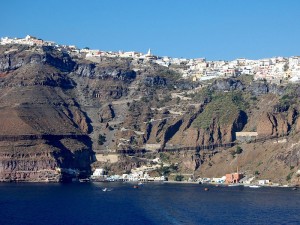 SANTORINI (THIRA)
SANTORINI (THIRA)
Santorini, the southern most island of the Cyclades, is thought of by many as the most spectacular of the Greek islands. The submerged caldera (crater) is a vestige of what was most likely one of the most catastrophic volcanic eruptions in recorded history. Tourism has not diminished the dramatic atmosphere of Fira. Terraced into the volcanic cliffs are barrel-roofed cave houses and domed churches. Along the lip of the caldera are several bars and restaurants, the view of the cliffs and their multicolored layers of lava and pumice, from here is breathtaking. Ships berth at Athinios, a tiny haven beneath the towering volcanic cliffs. In favorable weather, ships anchor offshore below Fira, whose dazzling white houses and domes extend along the cliff top nearly 210m above. Further north, thevillageofOiais also set on the steep slope of the caldera, many of its whitewashed buildings nestle in recesses in the volcanic rock. It is famous for its spectacular sunsets. The tiny port, Ammoudi lays 300 steps below Oia, it’s a lovely spot for a swim and a bite to eat. There are five commercial wineries to visit, they host tastings in the summer. The potent Santorini wine has a great reputation.
Ancient Akrotiri was a Minoan settlement, with buildings dating to the 16th century BC. Excavations started in 1967, have unearthed an ancient city beneath the volcanic ash. The site is defiantly worth a visit.
Beaches Santorini’s black sand beaches are beautiful but very hot. The nicest beaches are on the east coast, such as Perivolos, Perissa and Agios Georgios. The Mediterranean Dive Club in Perissa, offers volcanic and wreck dives. There is also Kamari, Monolithos Beach and Red Beach.
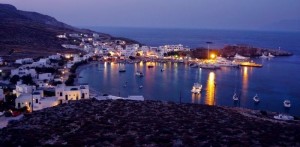 FOLEGANDROS
FOLEGANDROS
Most visitors come to peaceful Folegandros for the unspoilt island life. Boats dock in the small harbor of Karavostasison the east coast. Hora, the hidden cliff top village is perhaps the most beautiful capital in the Cyclades. The medieval kastro and the maze of narrow white washed streets and low archways date back to the 13th century. Bougainvillea cascade down the house’s wooden balconies. There are several good beaches to visit such as Agnali Beach, Agios Nikolaos, Livadaki and Agios Georgios.
